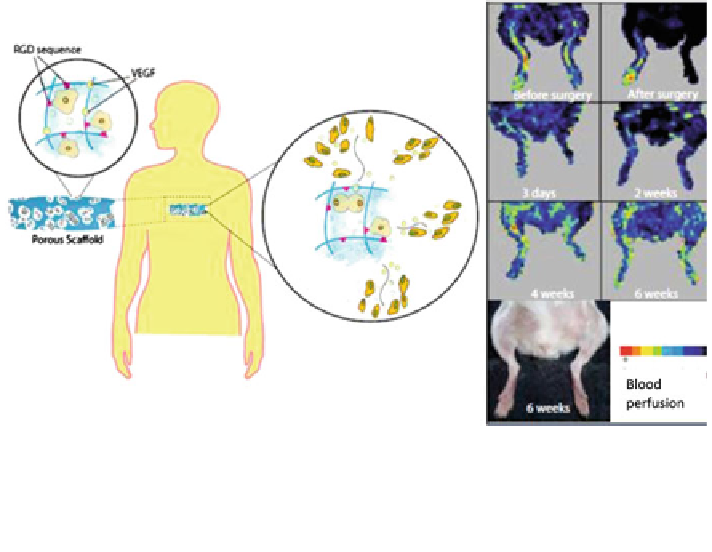Biomedical Engineering Reference
In-Depth Information
Fig. 8 Left Schematic of therapeutic application of a hydrogel designed to deploy transplanted
cells at an implantation site. Right Laser Doppler perfusion images of the recovery of blood flow
in a mouse's right hindlimb damaged by ligation of femoral artery. The implantation of cell-
deploying hydrogel consisting of porous alginate gel, VEGF
165
, EPC and OEC significantly
enhanced the recovery of blood perfusion [
29
]
PEGDA [
27
]. Alternatively, the PEG-based hydrogel is formed by cross-linking
PEGDA with oligopeptides cleaved by cell-secreting proteinases such as matrix
metalloproteinases (MMPs). Co-encapsulation of endothelial cells and mesen-
chymal progenitor cells in the MMP-sensitive synthetic hydrogel resulted in the
formation of tubule-like structures. The mesenchymal progenitor cells acted as a
source of MMPs to facilitate endothelial lumen formation.
These cell-encapsulating gels were further modified by encapsulating VEGF or
VEGF-encapsulating microparticles to stimulate endothelial differentiation of
encapsulated cells. In addition, these angiogenic factors may be essential to con-
nect the new blood vessels formed within the hydrogel with host blood vessels
neighboring the implanted gels. Implantation of these hydrogels encapsulated with
cells and VEGF into mouse corneas sans cells resulted in a vascular network that
penetrated the hydrogel implants within 7 days [
28
].
Conversely, hydrogels were used to dispatch cocktails of endothelial progenitor
cells (EPCs) and outgrowth endothelial cells (OECs) into target tissues following
implantation. EPCs and OECs produce multiple angiogenic growth factors and build
new endothelial lumen, respectively. The alginate hydrogels encapsulated with
VEGF
165
were lyophilized to introduce interconnected micropores and the cells were
incorporated into the hydrogel during the rehydration process. Alginates modified with
cells adhesion oligopeptides containing the Arg-Gly-Asp sequence were used to
ensure cell adhesion to the gel matrix. The sustained release of VEGF
165
from the
hydrogel stimulated the migration of EPCs and OECs from the hydrogel into

Search WWH ::

Custom Search